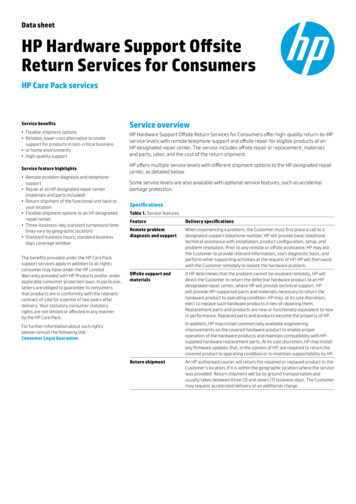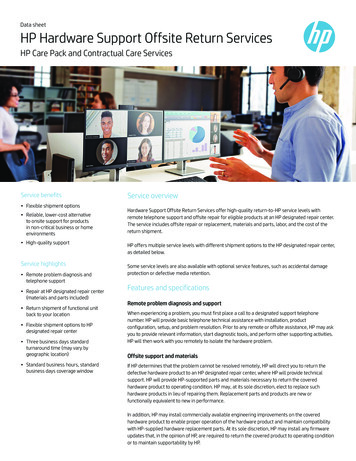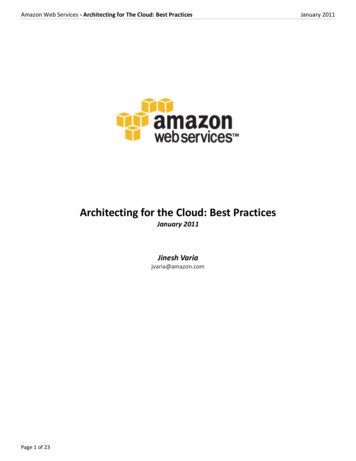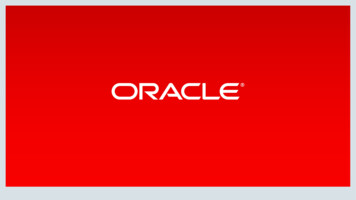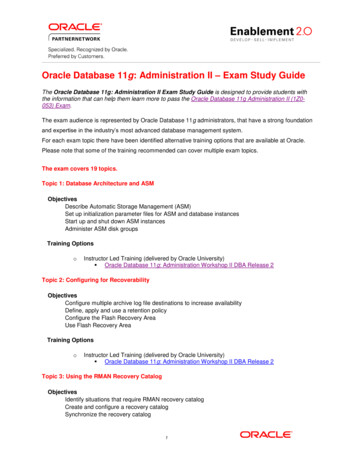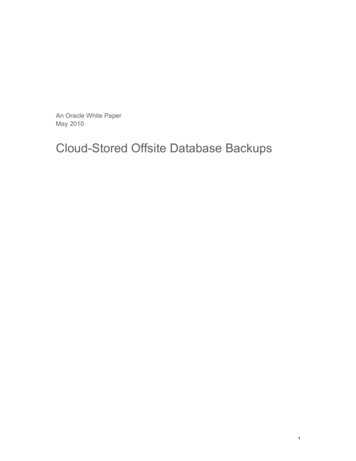
Transcription
An Oracle White PaperMay 2010Cloud-Stored Offsite Database Backups1
IntroductionCloud Computing allows users to tap into a virtually unlimited pool of computing and storageresources over the Internet (the Cloud). Unlike traditional IT, Cloud users typically have littleinsight or control over the underlying infrastructure, and they must interact with the computingand storage resources via an Application Programming Interface (API) provided by the Cloudvendors. In exchange for those constraints, Cloud users benefit from utility-like costs,scalability, and reliability, as well as the ability to self-provision resources dynamically and payonly for what they useThe ability to back up Oracle Database in the Cloud is a key part of Oracle’s Cloud offering. Itallows customers to use Storage Clouds, such as Amazon’s Simple Storage Service (S3), astheir next-generation offsite backup storage destination. Compared to traditional tape-basedoffsite storage, Cloud backups are more accessible, faster to restore under mostcircumstances, and more reliable. Cloud backups are also the right protection for databasesrunning within the compute Cloud.2
Why Backup Storage in the CloudGood Disaster Recovery (DR) practice requires keeping usable business-critical backups offsite.Organizations have traditionally implemented this by writing backups to tape and shipping the tapes tobe stored offsite. This is costly and operationally complex, requiring hardware, personnel, and soundprocedures to ensure that the offsite backups are up-to-date, secure, and able to be recalled and used inthe face of disaster. While shipping and secure storage are often outsourced, the IT organization of theenterprise retains the burden of ensuring the integrity of the backups and procedures.The pricing and operational characteristics of Cloud Storage make it a very compelling alternative toshipping tapes offsite. Cloud storage offers pay-as-you-go, elastic self-provisioning, with low prices 1per unit storage per unit time, making costs easy to predict, control, and map to the workloads of anorganization’s IT assets. Good Cloud infrastructure offers storage redundancy, security, availability andscalability with geographic distribution that enables it to absorb a broad range of adverse events withminimal or no loss of availability. These characteristics make it an excellent alternative to writing,shipping and storing tapes in a secure location. Last, but not least, backups are created and updatedover the network, with minimal or no operator involvement – drastically simplifying operationalprocedures.Amazon Web Services (AWS) is the first Cloud vendor that Oracle has partnered with to enabledatabase backup in the Cloud. Simple Storage Service (S3) is the main storage offering of AWS. S3’ssimple web-services interface enables applications to store and retrieve any amount of data fromanywhere on the Internet. S3 is a highly scalable, reliable, fast, inexpensive data storage infrastructure,and thousands of enterprises small and large rely on it for their production storage needs, from “cold”inexpensive storage to serving rich multimedia in real time to customers worldwide.Sending backups over the Internet to be stored in the Cloud benefits from the elasticity in capacity andoperational expenses typical of Cloud services. It can also simplify your own infrastructure as you nolonger need to provide and manage storage (e.g., tapes that need to be rotated, shipped away, etc.).An important objection to over-the-network Cloud backup is that limited network bandwidths in thepublic Internet preclude the fast transfer of large data amounts like those of a full backup of a largeproduction database. Amazon Web Services addresses this problem by offering S3 data import andexport services, which enable bulk movement of data into and out of S3 by shipping portable disks.For example, , after a disaster, S3 can express mail a portable hard drive containing all the backup datafor a given database. This makes the cloud storage offering comparable to storing tapes offsite,especially when it is done as part of a complete backup strategy that includes keeping backups onsite aswell as offsite.Storage Cloud benefits from the falling prices of the commodity disks underlying the infrastructure, andthe economies of scale of the Cloud operator.13
Oracle Secure Backup Cloud ModuleThe Oracle Secure Backup (OSB) Cloud Module enables an Oracle Database to send its backups toAmazon S3. It is compatible with Oracle Database versions 9i Release 2 and above, and it requires anetwork connection to the Internet, and provisioning the means of payment to Amazon WebServices.2 The Oracle Secure Backup Cloud module can also be used when the database is runningwithin the Amazon Elastic Compute Cloud (EC2), in which case it benefits from the higher internalnetwork bandwidth and no transfer costs into and out of S3.The Oracle Secure Backup Cloud module is implemented using the Oracle Recovery Manager(RMAN) SBT interface. The SBT interface allows external backup libraries to be seamlessly integratedwith RMAN. Consequently, database administrators can continue to use their existing backup tools –Enterprise Manager, RMAN and other scripts, etc. – to perform Cloud backups.OSB Cloud module is available for Linux 32 and 64, SPARC 64, and Windows 32.Complete Data Security with Built-in EncryptionOracle Secure Backup leverages RMAN's ability to encrypt backups to ensure data security. Datasecurity and privacy is particularly important in shared, publicly accessible environments such as theStorage Cloud. While most Storage Cloud vendors provide robust security to ensure that onlyauthorized users can access data, Oracle’s encryption of backup data before it leaves your databasefurther mitigates risk of theft or unauthorized access because the backup data remains encrypted bothin-transit and at rest in the Cloud.Compressed Backups for Better PerformanceIntegration with the Oracle Database engine enables Oracle Secure Backup to identify and skip unusedspace (blocks) within the database. Users also benefit from RMAN’s rich compression capabilities.When transmitting backups over slower networks, such as the public Internet, any reduction in backupsize is directly realized as an increase in backup performance.Database Version SupportThe Oracle Secure Backup Cloud Module may be used to back up the following supported versions ofOracle Database: Oracle Database 9i Release 2 or higher, including Oracle Database 11g.The Cloud Backup Module is a part of the Oracle Secure Backup product family, and licensed on a perRMAN channel basis. Oracle Secure Backup is Oracle’s next-generation tape backup management solutionand it now provides customers the flexibility to back up data to either tape or the Cloud.24
Figure 1. Oracle Database backup in the CloudBenefits of Oracle Cloud BackupOracle’s Cloud backup functionality provides advantages over traditional tape-based offsite backups: Continuous Accessibility: Backups stored in the Cloud are always accessible – much in the sameway local disk backups are. As such, there is no need to call anyone and no need to ship or loadtapes before a restore can be performed. Administrators can initiate restore operations using theirstandard tools (Enterprise Manager, scripts, etc.) just as if the offsite backup was stored locally. Thiscan help make restores faster and reduce down time from days to hours/minutes in many cases. Forlarge databases where shipping a portable disk from the Cloud is required, a restore takes no longerthan it would take to have a tape recalled from an offsite location. High Reliability: Storage Clouds are disk based and thus inherently more reliable than tapes.Additionally, Cloud vendors typically keep multiple redundant copies of data for availability andscalability purposes. (See AWS's S3 Service Level Agreement and FAQs.) Unlimited Scaling and No Up-front Capital Expense: The Cloud provides virtually unlimitedcapacity with no up-front capital expenditure. Consequently, users need not worry aboutprovisioning adequate tapes or local storage to hold the required backup data. The Cloud scalesseamlessly and users pay only for what they use, when they use it. Reduced Tape Backup and Offsite Storage Cost: Since Cloud backup reduces or eliminates theneed for tapes, this can lead to significant savings in tape backup software licensing/support andoffsite tape storage costs. Easy Provisioning of Test and Dev Environments: As Cloud Backups are accessible fromanywhere via the Internet, they can be used to quickly clone databases to create custom test,development, or QA environments. For instance, Cloud Backups stored in Amazon S3 can becloned to machines running in Amazon EC2 by running a simple script that is included in theOracle-provided Amazon Machine Images (AMIs). An AMI is a virtual machine image that allowsquick provisioning of a pre-installed and pre-configured Oracle database environment on AmazonEC2.5
Getting Started with Cloud BackupThis section explains how to provide the means of payment to Amazon to use their storage cloud, andhow to obtain and configure the OSB Cloud module with your Oracle Database.Sign up for Amazon S3The first step in getting started with the Oracle Secure Backup Cloud module is to sign up for AmazonS3. This can be done by visiting the Amazon S3 website (http://aws.amazon.com/s3). Uponsuccessful registration, users will be provided a pair of access identifiers called the Access Key ID andthe Secret Access Key.Register for an Oracle.com or Oracle Technology Network (OTN) AccountAn Oracle.com or OTN account is required to install the Oracle Secure Backup Cloud module. Newaccounts may be created by visiting the OTN website (http://otn.oracle.com).Install the Oracle Secure Backup Cloud ModuleThe next step is to download the Oracle Secure Backup Cloud module install tool from OTN's Cloudwebpage, and run it to install and configure Cloud backups. Oracle Amazon Machine Images (AMI) onAWS's EC2 already include this install tool. Therefore, if the database being backed up is running onAmazon EC2, there is no need to download the install tool – it can be found in the/home/oracle/scripts/osbws directory.The install tool can be invoked as follows (you must supply your OTN and AWS credentials): java -jar osbws install.jar -AWSID AWS ID -AWSKey AWS Secret Key -otnUser OTN User ID -otnPass OTN Password -walletDir WalletDirectory -configFile Cloud Backup Configuration File Name -libDir Location to store Cloud Backup Module/Library -proxyHost wwwproxy.yourcompany.com –proxyPort your proxy port Oracle Secure Backup Database Web-Service Install ToolOTN userid is valid.AWS credentials are valid.Creating new registration for this S3 user.Created new log bucket.Registration ID: 0f0a8aac-dad0-6254-7d70-be4ac4f112c4S3 Logging Bucket: oracle-log-jane-doe-1Create credential oracle.security.client.connect string1OSB web-services wallet created in directory /orclhome/dbs/osbws wallet.OSB web-services initialization file /orclhome/dbs/osbwst1.ora created.Downloading OSB Web Services Software Library.Downloaded 13165919 bytes in 204 seconds.Transfer rate was 64538 bytes/second.6
Download complete.Extracted file /orclhome/lib/libosbws11.soExample 1: Running the Cloud Backup Install ToolExample 1 above shows how the tool automatically performs all the required steps to install andconfigure the Cloud backup module – downloading the software, creating a wallet containing the user’sAWS identifiers, and creating the Cloud backup configuration file. More details on how to run theinstall tool and the description of all of its arguments can be found in the install tool readmedocument.Configure Recovery Manager (RMAN) SettingsThis step stores the configuration information for the Cloud Backup module in the RMAN repositoryso that it does not need to be specified each time a backup is invoked.RMAN configure channel device type sbt parms'SBT LIBRARY /orclhome/lib/libosbws11.soENV (OSB WS PFILE /orclhome/dbs/osbwst1.ora)';using target database control file instead of recovery catalognew RMAN configuration parameters:CONFIGURE CHANNEL DEVICE TYPE 'SBT TAPE' PARMS'SBT LIBRARY /orclhome/lib/libosbws11.soENV (OSB WS PFILE /orclhome/dbs/osbwst1.ora)';new RMAN configuration parameters are successfully storedExample 2: Configuring RMANOnce the RMAN configuration is completed, Cloud Backups can be performed using the same RMANcommands you usually use. This step is optional but strongly recommended.Cataloguing and Using Cloud BackupsAll Cloud backup operations will be catalogued by RMAN in the same manner as local disk or tapebackups are, ensuring a seamless restore/recovery process. When a restore/recover operation isinitiated, RMAN and Oracle Secure Backup Cloud module will automatically restore the required datafrom the Cloud - without requiring any special user intervention.7
Cloud Backup Best PracticesSecuring Data in the CloudOracle strongly recommends encrypting your Cloud backups. Encrypting backups ensures that yourdata remains secure and protected against unauthorized access. Please refer to Oracle Backup andRecovery Guide to learn more about the RMAN commands that are used to configure backupencryption. Encryption can also be enabled while scheduling backups in Enterprise Manager.Optimizing Cloud Backup PerformanceAs Cloud Backups are sent over the public Internet, performance is dependent on Internet networkthroughput – typically less than 1 MB/Sec per connection. Additionally, Cloud vendors may throttlesessions to prevent individual users from consuming disproportionate amounts of resources.According to internal tests conducted at Oracle, Amazon S3 limits an individual session’s read/writethroughput to around 2-3 MB/Sec. However by using the right combination of parallelism andcompression, backup speeds of up to 40-50 MB/Sec were attained; test results are summarized inTable 1, below. Some observations follow from these tests: Cloud Backups of your on-premise (off-cloud) databases are slower than for databases running onEC2. This is due to public Internet network bandwidth constraints. Compression helps overcome the network bandwidth limitations. For a database at Oracle HQ, theuse of compression resulted in a 4X gain in backup speed. Using parallel streams (RMAN channels) also speeds up Cloud backups – particularly for on-premisedatabases. As can be seen in Table 1, peak performance for a database at Oracle HQ was achievedwith 64 channels.Oracle recommends the following to optimize the performance of Cloud Backups: Use multiple RMAN channels for higher parallelism resulting in full utilization of the network.Use multi-section backups. Oracle Database 11g allows multiple channels to back up a single file inparallel, increasing parallelism beyond the number of datafiles to be backed up. For example, theRMAN command to specify backup section size 1 GB is:BACKUP DEVICE TYPE SBT DATABASE SECTION SIZE 1g; Use the Oracle Database 11g Advanced Compression. Oracle Database 11g Compression issignificantly faster and more efficient (in terms of CPU overhead) than pre-11g compression. Consider making full database backups once a week and performing incremental backups during theweekdays. This will results in faster backups and may help save significant amount of networkbandwidth. Use the RMAN Block Change Tracking feature to optimize the performance of yourdaily incremental backups.8
TestEnvironmentUncompressedBackup Speed(NetworkThroughput)CompressedBackup SpeedFull DBBackupTime (250GB)Incremental BackupTime (10% delta)DB at OracleHQ10 MBPS40 MBPS2-6 Hours30 Minutes – 1 Hour(64 RMANChannels)(64 RMANChannels)35 MBPS50 MBPS Constrained byCPU (32 RMANChannels)2 Hours 20 Minutes(8 x 2 GHz CPU, 16GB RAM)DB withinAmazon Cloud(Extra Large EC2(16 RMANChannels)Instance)Table 1: Cloud Backup PerformanceConclusionThe Oracle Database Cloud Module allows customers to use Amazon’s Simple Storage Service (S3) astheir offsite backup storage destination. Compared to traditional tape-based offsite storage, Cloudbackups are more accessible, faster to restore under most circumstances, and more reliable, whileeliminating the overheads associated with maintaining off-site backup operations.Cloud backups are also the optimal protection for databases running within the compute Cloud.9
Cloud-Stored Offsite Database BackupsMay 2010Author: Cris PedregalCopyright 2010, Oracle and/or its affiliates. All rights reserved.Contributing Authors: Bill Hodak, MuthuThis document is provided for information purposes only and the contents hereof are subject to change without notice. ThisOlagappandocument is not warranted to be error-free, nor subject to any other warranties or conditions, whether expressed orally or implied inlaw, including implied warranties and conditions of merchantability or fitness for a particular purpose. We specifically disclaim anyOracle Corporationliability with respect to this document and no contractual obligations are formed either directly or indirectly by this document. ThisWorld Headquartersdocument may not be reproduced or transmitted in any form or by any means, electronic or mechanical, for any purpose, without our500 Oracle Parkwayprior written permission.Redwood Shores, CA 94065U.S.A.Oracle and Java are registered trademarks of Oracle and/or its affiliates. Other names may be trademarks of their respective owners.Worldwide Inquiries:AMD, Opteron, the AMD logo, and the AMD Opteron logo are trademarks or registered trademarks of Advanced Micro Devices. IntelPhone: 1.650.506.7000and Intel Xeon are trademarks or registered trademarks of Intel Corporation. All SPARC trademarks are used under license and areFax: 1.650.506.7200trademarks or registered trademarks of SPARC International, Inc. UNIX is a registered trademark licensed through X/Openoracle.comCompany, Ltd. 0110
The Oracle Secure Backup Cloud Module may be used to back up the following supported versions of Oracle Database: Oracle Database 9i Release 2 or higher, including Oracle Database 11g. 2 The Cloud Backup Module is a part of the Oracle Secure Backup product family, and licensed on a per-RMAN channel basis.
